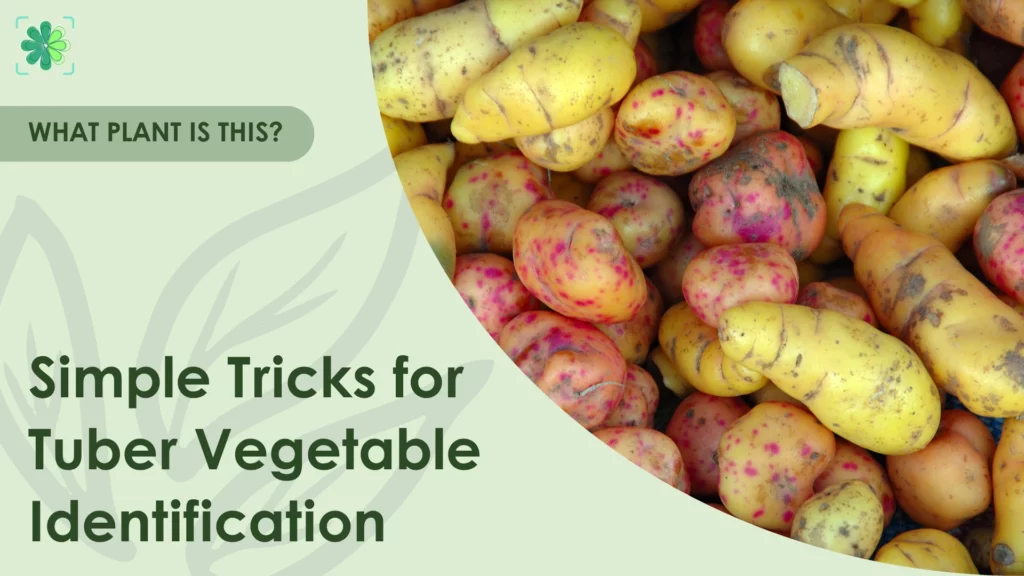
Tuber vegetable identification helps you recognize what’s hiding underground (like potatoes, cassava, or taro). This guide demonstrates how to distinguish tubers by their shape, texture, color, and internal characteristics. You’ll also learn the difference between stem and root tubers, plus how tubers differ from other underground plant parts like bulbs and corms. From everyday kitchen staples to lesser-known varieties, we cover everything you need to spot them with confidence.
What Are Tuber Vegetables?
Tuber vegetables are thickened underground parts of a plant that store energy in the form of starch. They help the plant survive harsh seasons and regrow when conditions improve. For us, they’ve become valuable food sources packed with carbs and nutrients.
What makes them unique? While they might look similar to other underground crops, tuber vegetable identification focuses on a few key differences:
- Vs. Bulbs: Bulbs (like onions) have layered structures and a basal plate, while tubers don’t.
- Vs. Corms: Corms are solid stem bases with a tunic, whereas tubers are swollen with scattered buds or “eyes.”
- Vs. True roots: Root vegetables like carrots grow from the primary root; tubers are modified storage organs and often regrow from buds.
So next time you spot something knobby and starchy below ground, ask yourself: is it storing energy to survive, or just part of a root? That question is the heart of identifying an actual tuber.
Types of Tubers: Stem vs. Root Tubers
To identify tubers accurately, it’s helpful to know they come in two primary forms: stem tubers and root tubers.
1. Stem Tubers
These are thickened underground stolons or rhizomes (stem tissues that swell to store nutrients). A classic example is the potato, which grows from thickened stolons. Internally, stem tubers have nodes (the “eyes”) and internodes, with each eye able to sprout into a new shoot, making them a potent means of vegetative propagation.
2. Root Tubers
These are enlarged lateral roots, similar to those found in sweet potatoes or cassava, that swell to store carbohydrates. Unlike stem tubers, they lack nodes and internodes but can still regenerate via adventitious buds at the crown (the base part next to the stem).
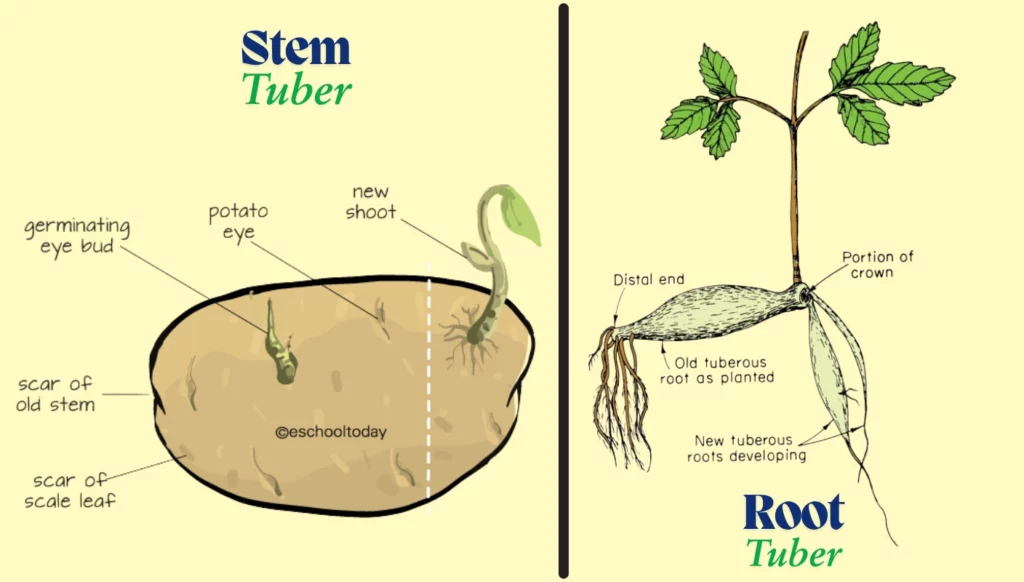
Key Tuber Vegetable Identification Features
Knowing how to distinguish one tuber from another is about understanding the physical clues that reveal what you’re looking at. For proper tuber vegetable identification, you need to look at both what’s on the surface and what’s inside.
1. Shape and Size
Tubers can range from perfectly round to long, tapered, or irregularly knobby. Their shape is often influenced by how they grow in soil, whether they spread horizontally, grow downward, or cluster around a central point. Size also varies widely, from small and compact to large and bulky. These physical proportions can provide subtle clues about the plant’s growth habit and its classification as a root or stem tuber.
2. Skin Texture
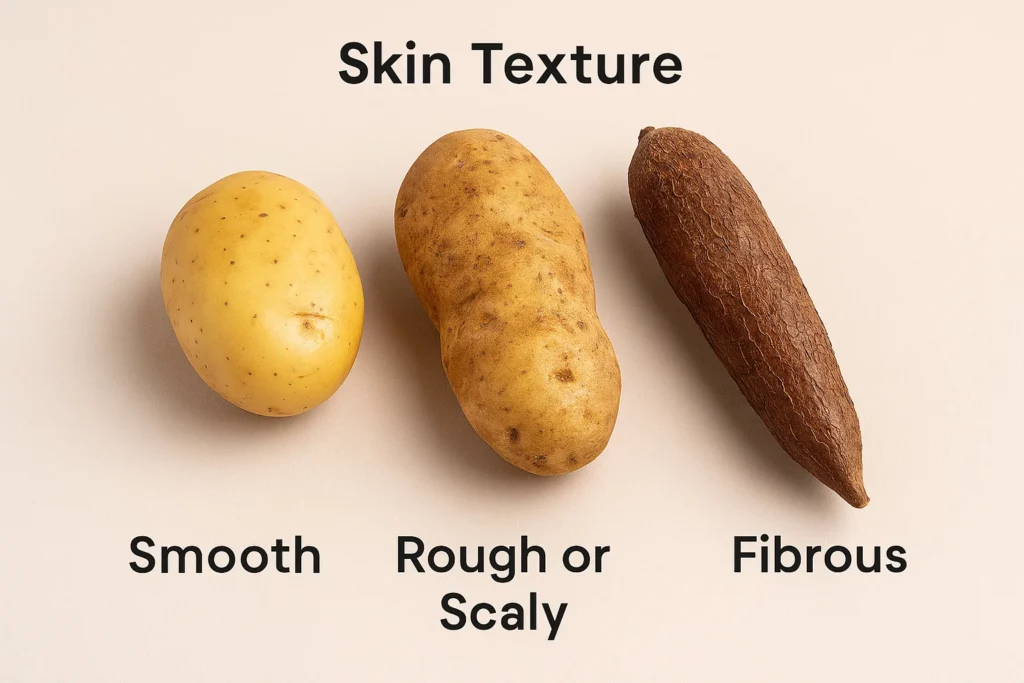
The feel and appearance of the skin often offer the first clue. In tuber vegetable identification, this is especially useful when you don’t have the flesh exposed.
- Smooth skins (like in young potatoes or jicama) usually indicate a thinner outer layer and easier handling in the kitchen.
- Rough or scaly skins, common in yams and some taro, may suggest a more mature or fibrous texture inside.
- Fibrous or bark-like textures, like those of cassava, often require peeling or soaking before cooking and can signal high starch content.
Texture also affects how long a tuber can be stored—rough-skinned tubers tend to be more durable.
3. Flesh Color
Once sliced open, the interior color can tell you a lot. It’s a reliable clue for species, cultivar, and even nutritional value.
- White flesh is typical in standard potatoes, taro, and certain types of yams.
- Yellow to orange flesh, especially in sweet potatoes, points to high beta-carotene content.
- Purple or deep red flesh is common in purple yams (ube), purple sweet potatoes, and some Andean tubers, such as oca.
These colors are biologically meaningful, making them essential for detailed tuber vegetable identification.
4. External Clues
Certain surface features are beneficial in distinguishing tubers that look similar at a glance.
- Eyes (buds): Unique to stem tubers, such as potatoes. Each eye is a node where new shoots can grow.
- Scars: Often from previous sprouting points or harvest damage. They may suggest age or handling quality.
- Root hairs: Fine, hair-like structures visible in root tubers like cassava or sweet potato, indicating their origin in the root system.
- Crown or growing tip: Present at the base of root tubers; this is where stems or vines begin to form during regrowth.
5. Internal Clues
Sometimes you’ll need to cut the tuber open to identify it with confidence.
- Cross-sections: Potatoes often show clear vascular rings, while cassava has a more solid, fibrous interior.
- Fiber lines: These stringy or grainy textures inside are typical of mature root tubers, especially cassava and large sweet potatoes.
- Color variations: Some tubers have white exteriors but vibrantly colored interiors (like purple ube). These contrasts are helpful identifiers, particularly in heirloom or less commercially available varieties.
Cutting open a tuber not only helps confirm its identity but also gives insight into freshness, ripeness, and edibility.
Common and Lesser-Known Tuber Vegetables (With ID Tips)
Below is a breakdown of both familiar and lesser-known species, with key features to support precise tuber vegetable identification.
Well-Known Tubers
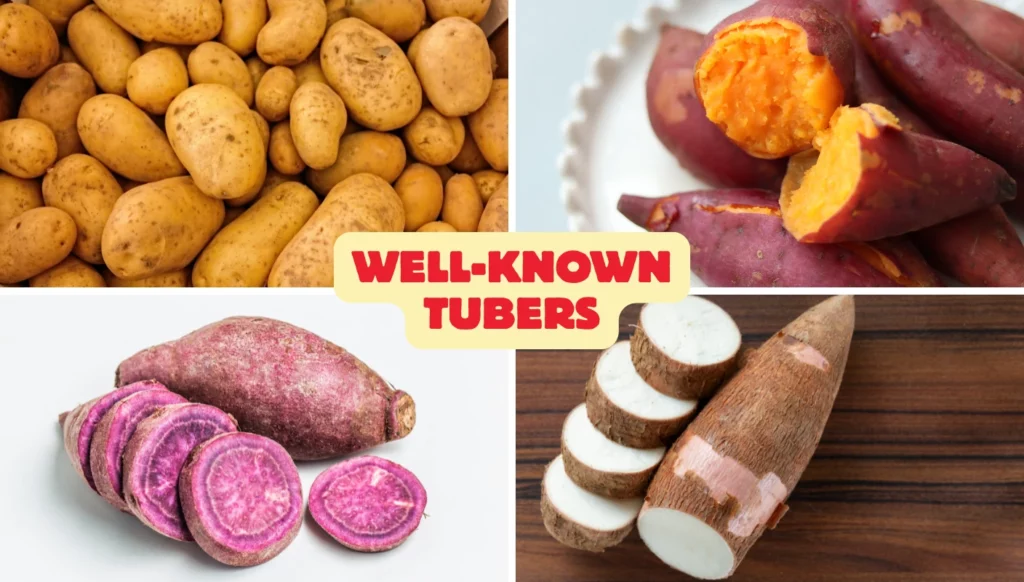
These are the tubers you’re most likely to see in supermarkets, home gardens, and global cuisines. Their appearances may seem familiar, but subtle differences are crucial for proper identification.
1. Potato (Solanum tuberosum)
A stem tuber with clearly visible eyes (small buds capable of sprouting). Potatoes typically have thin, smooth to slightly rough skin and are available in round or oblong shapes. Skin and flesh color can range from white to red or purple, but the presence of eyes remains the most reliable tuber vegetable identification clue.
2. Sweet Potato (Ipomoea batatas)
A root tuber with no eyes or stem nodes. Its tapered shape, dense orange or purple flesh, and thin skin make it stand out. The surface may show faint root hairs, especially near the crown. Despite the name, it is botanically distinct from yams.
3. Yam (Dioscorea spp.)
Typically large, heavy, and covered in rough, dark, scaly skin. The interior is often dry and starchy with white to off-white flesh. Unlike sweet potatoes, yams are true monocots and do not have eyes. In tuber vegetable identification, size, skin coarseness, and dryness of flesh are key indicators.
4. Cassava (Manihot esculenta)
Long and cylindrical with tough, woody, brown skin. A cross-section reveals firm white flesh with stringy fiber lines. It contains naturally occurring cyanogenic compounds, so proper cooking is essential. The crown or root tip is a helpful external clue.
Lesser-Known Tubers
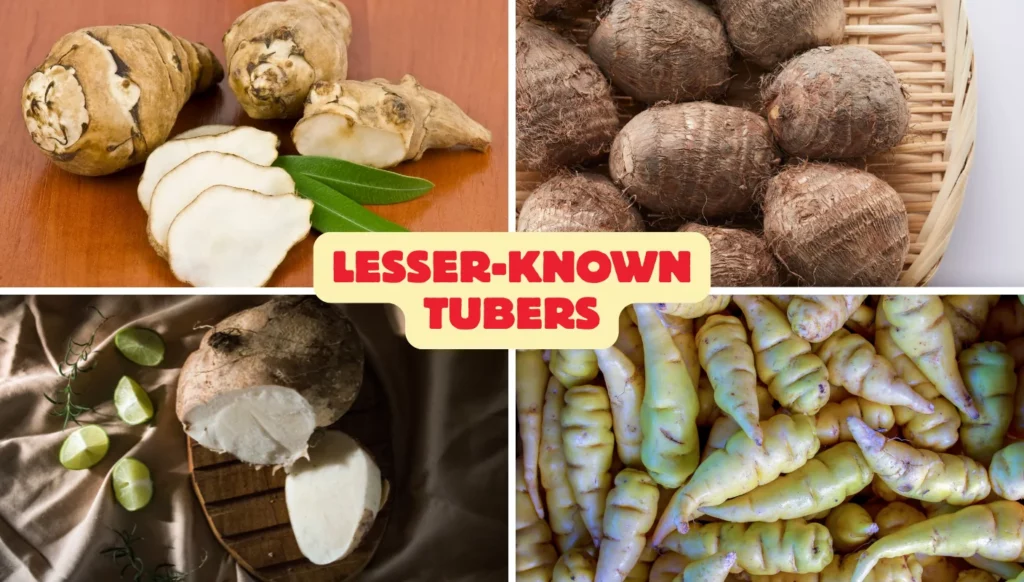
These species are often overlooked outside of specific regions, but they add diversity to the tuber world. Recognizing them expands your understanding of global root crops.
5. Jerusalem Artichoke (Helianthus tuberosus)
A knobby, irregular tuber with thin, light-brown skin and crisp, white flesh. It resembles ginger in shape but is part of the sunflower family. It’s typically eaten raw or lightly cooked and doesn’t contain starch in the same way as potatoes.
6. Taro (Colocasia esculenta)
A small to medium tuber with fibrous, hairy skin. Its flesh is white or lavender and may cause skin irritation if peeled raw. Since it contains calcium oxalate, thorough cooking is required. In tuber vegetable identification, the hairy surface and the need for detoxification are key flags.
7. Jicama (Pachyrhizus erosus)
Round to turnip-shaped with smooth, tan skin. Inside, it has a juicy, crisp white interior that stays crunchy even after cutting. It’s commonly eaten raw and is known for its high water content and mild sweetness. Lack of eyes and stem clues confirms it’s a root tuber.
8. Oca, Ulluco, Mashua
These Andean natives come in vibrant colors (yellow, pink, red, or purple) and show a wide range of shapes. Oca is small and waxy, ulluco has a shiny surface with gelatinous flesh, and mashua is elongated with spicy notes when raw. For tuber vegetable identification, color and cultural origin are strong indicators, especially when dealing with less commercially available varieties.
Global and Cultural Contexts: Where Tuber Vegetables Matter Most?
Tuber vegetables aren’t just agricultural products; they’re cultural symbols shaped by history, migration, and trade. In different regions of the world, the same tuber might go by multiple names, or different tubers might share one name. For accurate tuber vegetable identification, you need to consider not only how a tuber looks, but also where it comes from and what it’s called locally.
Africa – Yams
In West Africa, true yams (Dioscorea species) are essential staples with deep cultural roots. They’re large, starchy, and rough-skinned, often used in traditional dishes like pounded yams or yam porridge.
Naming confusion: During the transatlantic slave trade, African people in the Americas began calling orange-fleshed sweet potatoes “yams” because they resembled the yams from home. The name stuck, especially in the U.S., despite sweet potatoes and true yams being botanically unrelated. This historical overlap still confuses today.
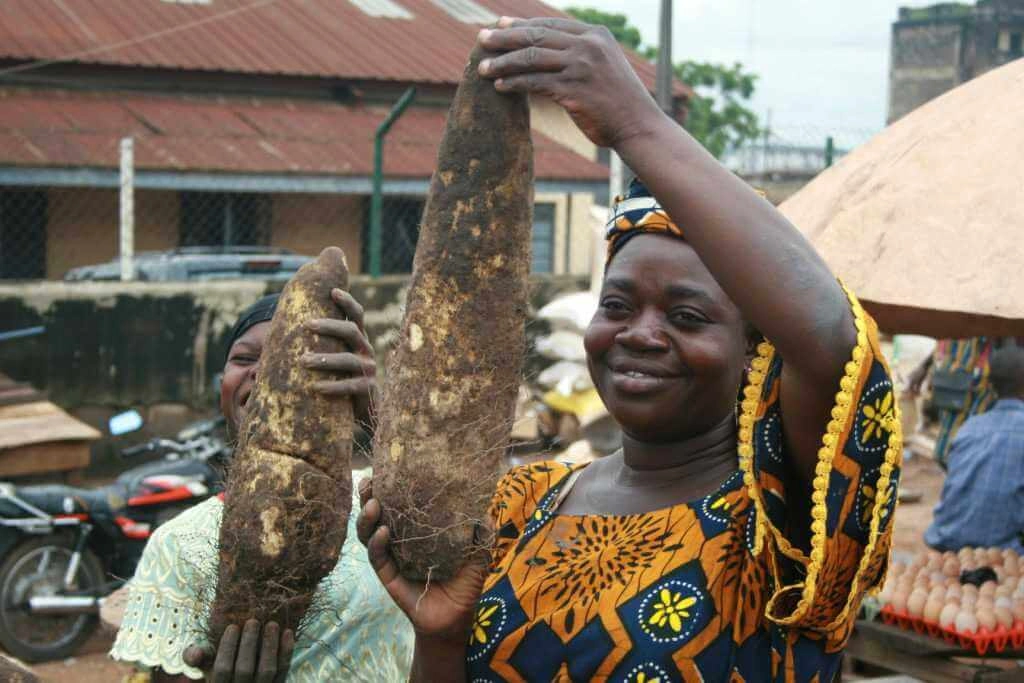
Women in Benin holding yams during a harvest festival.
South America – Cassava and Andean Tubers
Cassava is a key survival crop across much of South America, valued for its resilience and high-calorie yield. In the Andean highlands, people cultivate vibrant native tubers, including oca, ulluco, and mashua, each with distinct shapes and textures that reflect centuries of cultivation.
Naming confusion: In Spanish-speaking countries, cassava is called yuca, but in English, it’s often confused with yucca, a completely different ornamental plant that’s not edible. This one-letter difference leads to frequent mix-ups in grocery stores, recipes, and food labels.

A woman peeling cassava for attieke preparation.
Southeast Asia and the Pacific – Taro
Taro plays a central role in food traditions across Southeast Asia and the Pacific Islands. It’s commonly used in soups, desserts, and ceremonial dishes. Though it’s technically a corm, not an actual tuber, it’s often grouped with tubers due to its similar use and appearance.
Naming confusion: Taro is known by many names, including taro, eddoe, dasheen, or local terms such as khoai môn in Vietnam. These names refer to different varieties, but they often get used interchangeably. Without regional context, it’s easy to misidentify them, especially when appearance alone isn’t enough.
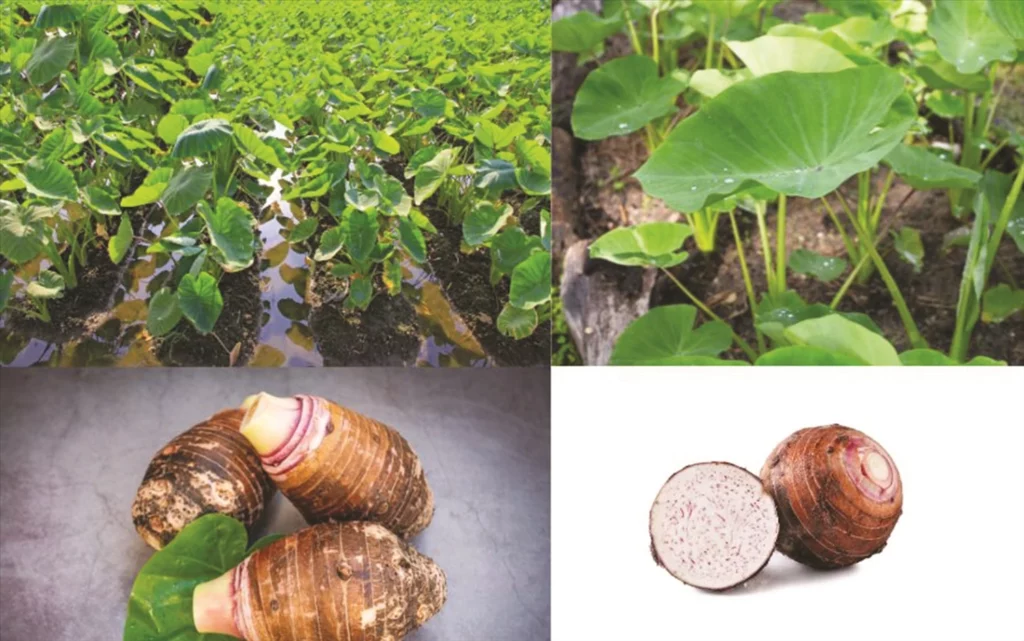
Conclusion
In the end, accurate tuber vegetable identification comes down to knowing what to look for and asking when you’re unsure. With so many regional names and lookalikes, it’s easy to get confused. That’s where the Planteyes app helps — chat with it anytime to identify plants with ease.
FAQs
What’s the difference between a tuber and a root vegetable?
A tuber is a swollen underground plant part that stores nutrients and can produce new shoots. It can be a modified stem (like potato) or root (like cassava). A root vegetable, on the other hand, refers specifically to true roots like carrots or beets that grow downward and don’t have nodes or buds.
How can I tell the difference between a yam and a sweet potato?
Yams have rough, scaly, dark brown skin and dry, starchy white flesh. They’re usually long and thick. Sweet potatoes have smoother skin, often reddish or tan, and moist, orange or purple flesh. Also, sweet potatoes may taper at the ends, while yams are more cylindrical.
Which tubers are safe to eat raw, and which ones must be cooked?
Tubers like jicama and Jerusalem artichoke can be eaten raw. Others, such as cassava, taro, and yam, must be cooked to remove natural toxins or irritants. Cassava, in particular, contains cyanogenic compounds and should never be eaten raw.
Can I grow tuber vegetables at home, and how do I identify them while growing?
Yes. The Planteyes app helps users identify tuber vegetables by analyzing photos of leaves, tubers, or whole plants. More than just a scanner, Planteyes includes a built-in chat feature, so you can ask questions directly, like chatting with an AI assistant, and get instant answers about what you’re seeing.


